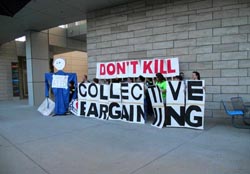
Meet solidarity, the next generation: Eric Lindberg - Communications Workers of America (Local 9423) secretary-treasurer and co-founder of the Next Generation Bay Area group - is armed with social media savvy and is on a mission to reignite the US labor movement.
By Niesha Lofing – President, Pacific Media Workers Guild.
February 21, 2012

Photo by Eric Lindberg.
The goal was to draw attention to a decision in San Jose that could have stripped collective bargaining rights from workers. So about 25 members of the CWA Next Generation Bay Area group donned zombie gear, marched down to a music event at a city park and held a flash mob. Then they camped overnight in support of workers.
The group has about 50 active members, with 150 more involved via email. They hold at least three events a month not including activities like voter registration drives. They attend alliance events, hold happy hours and raise awareness around social justice issues.
“With the lack of education that happens surrounding social justice and workers rights in schools right now, it’s extremely important for us to educate and empower individuals because it’s the people who make change,” said Eric Lindberg, secretary-treasurer of CWA Local 9423 and co-founder of the Next Generation Bay Area group. “Change doesn’t just happen by itself.”
Meet solidarity, the next generation.
Organized groups of younger union members and activists have begun emerging in recent months and years, a trend that labor leaders and experts, as well as young union members themselves, recognize as vital to the labor movement. The trend also is spurred by the AFL-CIO’s Next Up Young Workers Conference, a dynamic summit created in 2010 for young activists focused on mobilizing, organizing and energizing future generations of workers.
In recent years, six national unions – the CWA, Steelworkers, Electrical Workers, Office and Professional Employees, Painters and Allied Trades and Utility Workers – have passed resolutions and allocated resources to support young workers and get them more involved in union leadership.
“Young people are being told that they just have to suck it up and live in a world without jobs. We’re being told that America can’t afford teachers, but we can afford CEO tax cuts. We’re being asked to accept a society that rewards wealth and punishes work. A society that makes it harder for young people to go to college. A society where hate is growing … It’s shameful,” said Liz Shuler, secretary-treasurer of the AFL-CIO, in her keynote address during the Next Up conference held last fall. “The economic and social problems, the hate and the fear we see around us this day can only be solved by a fresh generation of committed, smart, tireless and creative activists.”
Younger workers are desperately needed to help refuel the labor movement, which like the workforce in general, has grown much older in its composition.
In 1983, the typical union worker was 38 years old, while in 2008, the typical union worker was 45 years old, according to a study by the Washington D.C.-based Center for Economic and Policy Research.
Part of that is due to the Baby Boomers and workers getting older, but the decline in the labor movement also is to blame, said Kris Warner, who co-authored the 2009 study with researcher John Schmitt.
In 2011, the most recent year for which there is data, the union membership rate was 11.8 percent, according to the U.S. Bureau of Labor Statistics. In 1983, the first year for which comparable union data was available, the union membership rate was 20.1 percent.
“The labor movement needs young people,” Warner said. “You can’t just have it being older folks and no one there to replenish the older folks. But the young people also need the labor movement.”
Unionized workers between the ages of 18 and 29 earned on average 12.4 percent more income than their non-unionized peers.
But it’s up to unions – and groups like the Young Workers of Northern California – to ensure that message is reaching future generations.
Helping promote union values is one of the missions of the Young Workers’ group.
“We’re trying to educate younger members about getting involved with their local unions and government,” said Pat Conaty, a member of IBEW Local 340 and the Young Workers. “Young people are going to be the leaders of tomorrow, and if we don’t educate them and pass along union values, it’s going to make it even harder for all of us … We need to keep those ideals strong for future generations so they’ll have a 40-hour work week, health plans and pensions.”
The Young Workers group has held two events and is planning another in early March. While it’s comprised mostly of union members, the group is open to anyone who wants to be involved, young or not.
“We’re trying to incorporate all young workers, because really, it’s everyone’s fight,” he said.
One of the toughest issues they have to overcome, however, is getting people to take time out of their lives to get involved in the movement. Conaty has been a member of the Electrical Workers union since he was 19, but is only now, at 32, becoming readily active.
“I realized that the less I’m involved, that’s one less person that’s able to help out,” he said. “If everyone has that attitude, you’ll end up with no one.”
Niesha Lofing, president of the Pacific Media Workers Guild, is managing editor of the Sacramento Valley Union Labor Bulletin, a nonprofit monthly publication of the Sacramento Central Labor Council and Sacramento-Sierra’s Building & Construction Trades Council.
Niesha Lofing


 The Hunger Site
The Hunger Site
February 23, 2012 at 9:46 am
Companies are making capital investments in China, sending manufacturing jobs there, while 11 million illegal immigrants drive the cost of labor down here, especially in the construction industry. Construction and manufacturing jobs have been the backbone of union labor. Now it is government jobs; but voters are now questioning what is the amount of services that they should provide, and how much they should pay civil workers. It is a tough time for unionized labor.